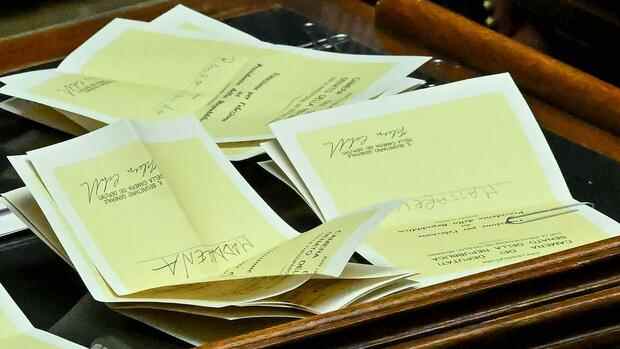Rome The second election day is coming to an end – and again the Italian newspapers are only reporting “black smoke”. Unlike in the neighboring Vatican, the smoke isn’t actually being blown out of the chimney to signal the world that we haven’t reached an agreement yet. Apart from that, the election of the Italian president is just as mysterious and inscrutable as the conclave on the papal succession.
As on Monday, when two-thirds of those eligible to vote cast blank ballots, there was a large majority of abstentions on Tuesday: 572 of the 1,009 eligible voters put a white piece of paper in the ballot box. Two names got 39 votes each: incumbent Sergio Mattarella, who has categorically ruled out staying in the Quirinal Palace for another seven years, and Paolo Maddalena, the former vice-president of the Constitutional Court. Far behind are politicians from all political camps. Even Silvio Berlusconi has seven points, although the former prime minister withdrew his self-declared candidacy at the weekend.
The name of the man who has actually been considered the big favorite for the presidency for months has not appeared on a single ballot so far: Prime Minister Mario Draghi. All of this doesn’t mean much, because the election is an eternal tactic, a political showdown between the parties. In the first three ballots, a two-thirds majority is needed, which hardly any candidate will be able to get together due to the strong polarization between the right and left camps.
The election is also dragging on because of Corona: A maximum of 50 voters are allowed into Parliament at the same time, disinfection has to be carried out in between, there is a drive-in voting station outside for Corona infected people and those who are in quarantine. Because of all these difficulties, only one ballot per day is scheduled. It only gets really exciting on Thursday, when the fourth ballot is scheduled. Then a simple majority of parliamentarians and regional delegates is enough – i.e. 505 votes.
Top jobs of the day
Find the best jobs now and
be notified by email.
There have been various meetings of the parties since Monday. They talk to each other, weigh up names, sound out majorities. Even if the office of the President is a rather representative one, similar to the German Federal President, a lot depends on it this time: The Draghi government has the country with a broad coalition from left to right, which has almost 80 percent of the seats in Parliament, brought through the corona pandemic well. The vaccination campaign was better organized than in many European countries, the economy is growing faster than elsewhere and Italy is finally catching up, even with long-overdue reforms.
Coalition around Draghi could burst
Foreign countries and the financial markets are therefore looking at the presidential election with concern. Because without Draghi as prime minister, the coalition could burst – in the worst case, there could even be new elections. The center-right camp, which is most likely to form a majority in a new election, threw up three presidential names today: former Education Minister Letizia Moratti, former Senate President Marcello Pera and ex-Judge Carlo Nodio.
The third ballot on Wednesday morning could show how seriously the nominations are meant. The centre-left camp has so far kept a low profile as far as possible candidates are concerned. But all of this could just be tactics. The really important candidates, who can be pushed through across party lines, will probably only come to light on Thursday.
More: With Berlusconi, a political veteran has just withdrawn his candidacy for Italy’s presidency. Why the election could set the country back.
